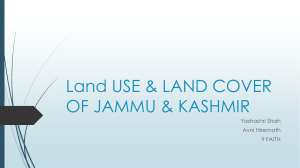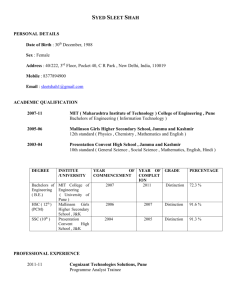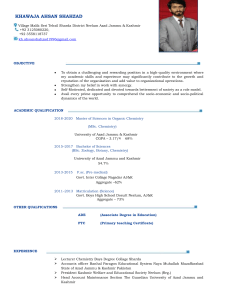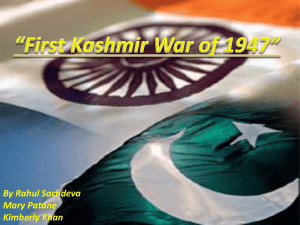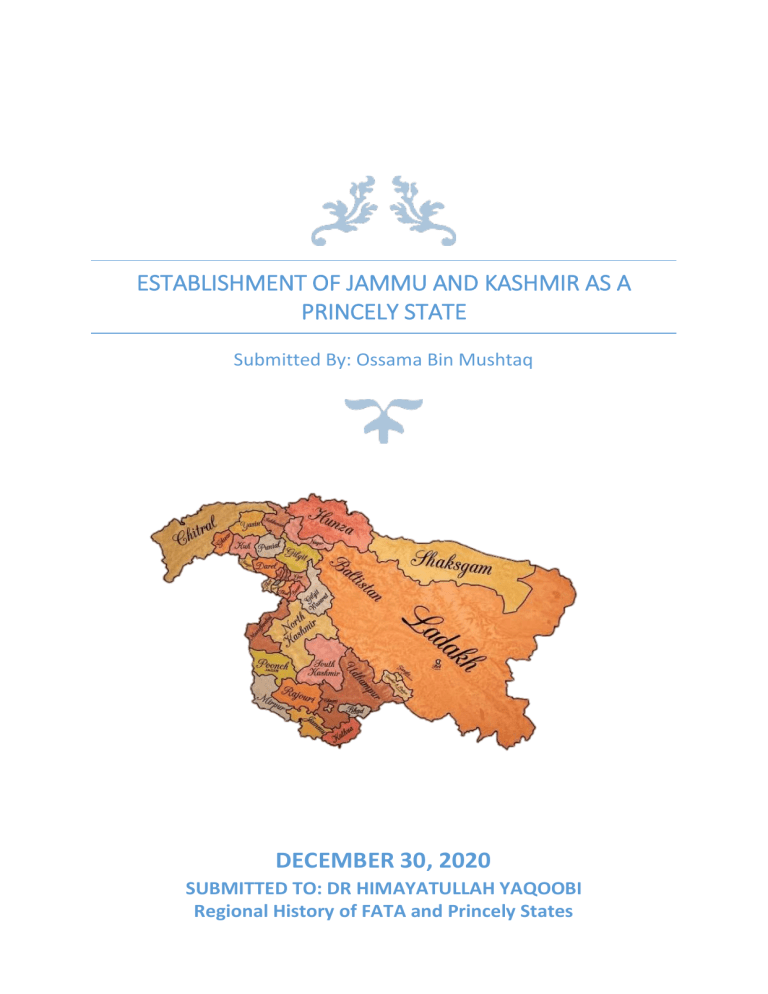
ESTABLISHMENT OF JAMMU AND KASHMIR AS A PRINCELY STATE Submitted By: Ossama Bin Mushtaq DECEMBER 30, 2020 SUBMITTED TO: DR HIMAYATULLAH YAQOOBI Regional History of FATA and Princely States Introduction Jammu and Kashmir was the northernmost princely state during the British rule in India from 1846 to 1947. The princely state was created as the result of an agreement known as the Treaty of Amritsar, between East India Company and Raja of Jammu Gulab Singh in 1846. Like other princely states of British India, in principle Maharaja of Kashmir was enjoying complete autonomy Official Emblem of State of Jammu and Kashmir over the internal affairs of governance, while he was dependant on the British Empire in the external affairs of the state including foreign relations and communications. He was bound to acknowledge the paramountcy of British power in return for recognition of their dynastic rule. Its geostrategic significance including hilly terrain, green vales, snow-capped mountains, and origin of major water sources made it unique in many prospects. This might be the reason that even after passing more than seventy-three years, the possession of J&K is a protracted issue between India and Pakistan. It was a multi-ethnic and multi-linguistic state, where the majority of people were Muslim while Hindus, Sikhs, Christians, Buddhists, and Jains, etc. constituted the minority population. Interestingly, the ruling family of J&K belonged to the upper-class Hindu Dogra Rajput clan of the Jammu region. They managed to rule over the state for exactly a hundred years till the time of decolonization of the British from the sub-continent. The atrocities of Dogras ruler towards their subject and their intents to establish Hindu-rule, raised animosity among the Muslims against their monarch. Due to the oppressive taxation policy, an indigenous revolt initiated to kick out the Dogra rule from their properties. So they started an armed struggle against the oppressive regime. As a result of partitions havocs in Punjab, communal riots broke out in the Jammu region as well. The intrusion of tribesmen from Pakistan also increased the complications for the Maharaja to maintain the law and order situation. To deal with this situation he signed an instrument of accession with the dominion 1 of India on 26 October 1947. This ultimately resulted in the disintegration of Jammu and Kashmir into three fragments which are now in control of India, Pakistan, and China. Geographical Location The erstwhile princely state of Jammu and Kashmir was located in the north-western part of the Indian subcontinent. Its area stretches from the mountain range of Himalaya in the North to the fringe of plains of river Indus in the South-West. While Himachal Pradesh lies on its South-Eastern border which extended to the province of Khyber Pakhtunkhwa (former NWFP) in the West. The total area of the region was 85,800 square miles (222,200 square km), which is still a matter of dispute b between India and Pakistan. Its terrain ranges from green lavish plains to high altitude glaciers, from fertile vales to deep forests and curving streams to astonishing waterfalls. The northern part of J&K is colder and of higher altitude, while it goes down and gets warmer towards the South. It has a diverse variety of natural habitats of different and unique species of animals and plants. The land is also enriched with precious minerals in the world. The Mughal Emperor Jahangir was so much impressed by its beauty that even on the deathbed he desired to visit Kashmir. Famous Persian poet Amir Khusro described the splendid beauty in these words that, if there is a heaven on Earth is nowhere else but it is here in Kashmir. It not only made the beauty of this land extravagant but vulnerable to foreign attacks for the accumulation of resources. All these factors made the J&K one of the most important geostrategic regions of the Indian Sub-continent. The history of this region could be traced back to around four thousand years. The oldest written account on the history of Kashmir is Raj Tarangini which comprised of the history of Kashmir from 2400 BCE. Though it has numerous chronological inaccuracies still there are several invaluable indications regarding the history of Kashmir that could be inferred from this manuscript. Until the 14th century, the region was ruled by several Hindus and Buddhists 2 dynastic rules. It was for the first time in 1339, when an indigenous Muslim ruler Shah Mir, laid the foundation of a Shah Mir dynasty which declined after few generations. So for the next four centuries, the rule of Kashmir was in the hand of Muslim monarchs. Mughals also reigned the Kashmir from 1586 to 1751. During the time of the Mughal Empire, the region has gone through many infrastructural advancements. Numerous gardens, mosques, roads, and seminaries were built during this era. There are still remains of fortification of this age. The Mughal control over Kashmir was ended with the invasions of Afghans in 1751. The local accounts consider this era to be the most challenging of all times. Here one thing which needed to be understood that throughout this era the locals were dependant on the governor appointed by Kabul for their daily affairs. The Durrani Empire period of influence ended in 1819 with the arrival of Sikhs on the crown of Lahore. Sikh Rule (1820-1846) After consolidating the several misls (confederacies) ruled by Sikh rulers, Ranjit Singh proclaimed himself as the Maharaj in 1801. The Treaty of Amritsar in 1901 declared the river Sutlej as the Southern border between the Lahore Darbar and British Empire in India. So instead of heading towards the East, Ranjit Singh expanded his boundary toward North and West. In this campaign, he managed to extend the authority of rule in Jammu, Kashmir, Multan, Peshawar, etc. After being remained under the reign of Muslim rulers Jammu and Kashmir went back to the hands of non-Muslims rulers. But this time it was the Sikhs who were going to rule out the region for the next twenty-six years. The previous rule of Afghans was so oppressive that initially, the locals welcomed the Sikh's rule. But later on, the rigid policies of the governor of Lahore Durbar changed their perspective about the Sikhs and it was also remembered as a tyrant rule like the previous. One of the reasons for their rigidness was might be the remoteness of Jammu and Kashmir from the center of Empire residing in Lahore. In the Sikh rule, there were several anti-Muslim laws were enacted which increased the resentment 3 among the locals. The cow slaughter was not only prohibited instead it was considered a serious crime whose punishment was the death penalty. The ancient Jamia Mosque of Srinagar was closed down for prayers while calling Azaan was also banned. The poor peasants were imposed with heavy taxes on lands and farming. It was the period when the revenue generated from Kashmir for Lahore was on the second number after Multan. The role of Gulab Singh (who later on became the first ruler of Jammu and Kashmir) in the Lahore Darbar was very vibrant in this era. Gulab Singh was a Hindu Rajput from the Jammu region. After the annexation of Jammu and Kashmir under Ranjit Singh’s Empire, he went into the service of Maharaja as a soldier in his Darbar. But his ambition and bravery ensured him to first appoint as the commander of a small regiment of Ranjits’s army and later on became the Raja of Jammu province in 1822. He sent a strong army under the commandership of Zorawar Singh on the campaign of North, including the region of Ladakh and Baltistan. Which he managed to capture in 1834 and 1841 respectively. He also maintained his hegemony over the Valley of Kashmir. The economy of Kashmir Valley was greatly dependant on the trade of Shawl wool. To establish his autonomy over it, he took control of all the trade routes. Though he had appointed to serve the Darbar, inwardly he had started to work on a different plan, which he managed to execute after the death of Ranjit Singh. After the death of Ranjit Singh in 1839, the Punjab Empire went into the hands of his incapable successors. Ranjit took the advantage of this loop and started consolidating his own empire in the region he had already established his authority. The Lahore Darbar which was already encircling in several internal threats was encountered to tough blow when the British East India Company expanded its claws toward Punjab. So after fighting two Anglo-Sikh wars in 1843 and 1846 respectively, ultimately the union of Punjab was annexed to British Empire, while Gulab Singh in the reward of his keen part in the weakening of Darbar was awarded to sustain the region of Jammu, Kashmir, Ladakh, etc., and rule over it under the paramountcy of British Empire. So ultimately a treaty, known 4 as Treaty of Amritsar was signed between Gulab Singh and the British East India Company at Amritsar on 16 March 1846. The treaty legitimated the rule of Gulab after the payment of 7.5 million rupee as the price of land situated in between of river Indus and Ravi. Treaty of Amritsar Gulab Singh was a shrewd person and crafty person. He foreseen the drastic consequences of Anglo-Sikh wars on the Punjab Empire, he shifted his loyalty toward the British. He played a vital role in soothing the situation in favour of the East India Company. In the reward of his services, the governor-general promised him to grant the hilly areas of Jammu and Kashmir. He was also allowed to establish his regime as an independent ruler. In this regard, the Treaty of Amritsar was signed between East India Maharaja Gulab Singh Reign. 1846-1857 Company and Gulab Singh to define the nature and conditions of the rule to be recognized. Some important features of the treaty include; The British transferred the possession of Jammu, Kashmir, and Ladakh for the everlasting period. The agreement would be considered worthwhile to all the successors of Maharaja. The Gulab Singh was asked to pay 75 lakh in lieu of the ownership. The Maharaja of Kashmir was directed to avoid any act which would contradict the interests of the British. Similarly, he was supposed to provide economic and military assistance, in case of any war erupted against the British. He was also bound to pay symbolic tribute annually to maintain the relations. In return, Gulab Singh was promised to maintain his statute without any interference, and also he was promised protection of external boundaries. The British intentionally gave control of the hilly region of Jammu and Kashmir to the local ruler who was loyal to them. The purpose of not keeping it under direct control was because they were aware of the geographical and strategic importance of this region. Due to the factor 5 of Russia and China, Britain formed it as a buffer zone that would provide them security. Secondly, it was a mountainous region which was very difficult to govern for them so easily. This tactic helped them a lot in the imminent years. Consolidation of Dogra Rule of Jammu and Kashmir After becoming the nominal ruler of Jammu and Kashmir, Gulab Singh introduced several reforms in administration and society of his possession. As the state was a sort of an artificial amalgamation of contrasting ethnicities, faiths, and regions. That is why it was not easy to form a coherent identity of the whole state-run. Ladakh which was Flag of Jammu and Kashmir 1846-1947 situated on the eastern part was culturally and religiously affiliated with Tibet, so Buddhists were in majority. Jammu had a complex demographic situation as it was a mixture of Muslims, Hindus, and Sikhs. While Kashmir was an overwhelmingly Muslim majority region, with a minute portion of Hindu minority comprised of Kashmiri pundits. In the northeast, the Baltistan and Gilgit regions had a population who was practicing Shia Islam. Some people consider this rule to be the most peaceful and tolerant time in the history of Kashmir as well as the other constituent parts of the state. But some believe that it was the worst era, in respect of their policies toward the Muslim subjects. In the initial years of the rule, the Dogra monarch consolidated and extend his territory. He moved toward the northeast and northwest where he managed to capture more territories including the region of Ladakh and Gilgit. Administratively the state was divided into several provinces, semi-autonomous region/ Jagirs, and frontier districts or Wizarat. According to the census reports of 1931, the state was divided into administrative units including Jammu Province, Kashmir Province, Wazarat of Ladakh and Gilgit, and Internal Jagirs of Poonch, Bhaderwah, and Chenani. Due to severe weather conditions the erstwhile state of Jammu and Kashmir had two capitals for performing the affairs 6 of state. The winter capital was Jammu while in summers the capital became shifted to Srinagar. Gulab Singh and his successor maintained the dynastic rule more like a feudal lordship. They considered the land and the people to be their personal property as they purchased them. As the Maharaja was a Hindu, so instead of giving equal opportunities to his subjects he had shown mores bias toward his own family. In all the administrative and military posts, the presence of any Muslim was negligible. The taxation policy of the rule was also discriminatory, as it mainly put more burden on the peasant and merchants of Kashmir than on the noble elites of Dogra lineage. The rule also restricted the Muslims and other religious groups to practice the rituals of their faiths. Freedom of speech and expression was also badly suppressed by using state machinery. The economy of most subjects was dependant on the agriculture and trade of wool. They were also restricted by imposing heavy taxation on them. Overall the Dogra's approach to consolidating their rule was through the use of force and strength, which they maintained to govern for complete one hundred years. Ultimately this artificial unification was finished in October 1947. 7 Bibliography Books Bose, Sumantra. Kashmir : Roots of Conflict, Path to Peace . Cambridge, MA: Harvard University Press, 2003. Hasan, Mushir ul. Kashmir Under The Sultans . New Delhi : Aakar Books , 2005. Lamb, Alastair. Kashmir: A Disputed Legacy 1846-1990. Karachi: Oxford University Press, 1991. Nisar. A. Malik, Abdul Majid. “Kashmir; in Historical Perspective.” JPUHS 29, no. 2 (December 2016): 1-10. Snedden, Christopher. Kashmir:: The Unwritten History . Delhi: HarperCollins, 2013. Journals Bhat, Sameer Ahmad. “State Formation in Colonial India: An Analysis of the.” International Journal of Scientific and Research Publications, 2016: 153-157. ZUTSHI, CHITRALEKHA. “Whither Kashmir Studies? : A Review.” Modern Asian Studies 46, no. 4 (2012): 1033–48. Anand, Adarsh Sein. “Accession of Jammu and Kashmir State - Historical and Legal Perspective.” Journal of the Indian Law Institute, 2001: 455-468. 8
